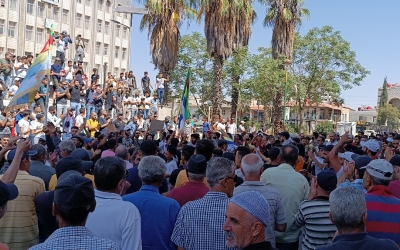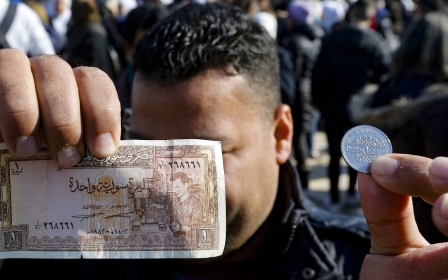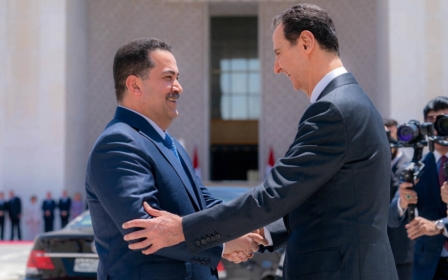Syria: Anti-Assad protests gain momentum as economic crisis bites
Anti-government protests gripped the south of Syria on Wednesday for the second consecutive week, as public demands for economic reform have escalated into calls for the departure of President Bashar al-Assad.
Hundreds of people have taken to the streets in Sweida, and in government-controlled parts of Aleppo, Daraa, Deir Ezzor and Jableh, protesting against their deteriorating living and economic conditions and calling for the release of political prisoners.
They also condemned what they described as ongoing corruption and poor governance.
“This is about holding Bashar al-Assad and the perpetrators of all violations accountable, and calling for the release of detainees and missing people,” Shadi al-Dubaisi, a 25-year-old protester from Sweida, told Middle East Eye.
The protests were triggered by the government's decision to cut fuel subsidies earlier this month, and have been galvanised by the continuing decline in the value of the Syrian lira.
New MEE newsletter: Jerusalem Dispatch
Sign up to get the latest insights and analysis on Israel-Palestine, alongside Turkey Unpacked and other MEE newsletters
Protesters have gathered in the city’s Karama Square on a daily basis. They block roads, chant, and remove photos and billboards of Assad. One video shared online showed demonstrators setting a billboard image of Assad on fire.
According to Dubaisi, there are around 35 or 40 demonstration points where people gather.
Government forces have reacted to the protests with force, and security forces have used live fire to intimidate protesters on some occasions.
A local TV channel, Syria Television, reported that the shootings took place in Shahba, in the north of the province, but no deaths were recorded.
“So far, all options are on the table," Dubaisi added. "No one knows how far we will get with this regime, but one thing for certain is that we as people will continue demonstrations and demanding the departure of the regime.”
Dignity and freedom
Asaad al-Omar*, a 32-year-old protester in Sweida, said the demonstrations have been peaceful so far, despite the response from security forces.
“We want to live in dignity and freedom… currently the regime is trying to provoke people to take up arms and sabotage the region, but we are peaceful,” he told MEE.
“Our most important demand is to overthrow the regime and take back our land. The regime sold the port, the airport, and Syria,” he added.
'We want to see an improvement to public services such as electricity and water, and for fuel prices to correspond to the income of an ordinary Syrian person'
- Abu Ali, protester
Abu Ali, a 66-year-old from Daraa al-Balad, also says he wants to live in “dignity and freedom” and have a democratic system in place.
“Our first demand is to call for the release of prisoners, and reveal the fate of those forcibly disappeared,” he explained.
“After that, we want to see an improvement to public services such as electricity and water, and for fuel prices to correspond to the income of an ordinary Syrian person,” he added.
Abu Ali says that the protests have not abated because people see the government as unsuitable in meeting the people's demands.
“All of these demands cannot be met by the current regime, and they are valid requests. So, our problems in Syria can only be solved by changing those in power, rebuilding the country and opening it up to the rest of the region, as well as moving away from Russia and Iran,” he said.
Many of the chants being heard in the protests are reminiscent of those used during the Syrian uprising of 2011.
Many shops engaged in a general strike last week, in frustration over the growing economic hardship and rising prices of basic goods.
Abdul Karim al-Omar, a political activist from Idlib, says the protests are “evidence of the Syrian people's dedication to the revolution and its values.
“There is no solution at all in Syria except the departure of this regime and the implementation of the UN International Resolution 2254, which starts with the formation of a transitional governing council,” he said.
Hundreds of people are still out on the streets, with many of the protesters hailing from the Druze community and the minority Alawite sect.
While Syrian authorities have largely kept silent about the protests, security forces have heightened patrols in many coastal areas.
The Syrian lira has dropped to around 13,800 pounds against one US dollar, further sinking a currency that began to collapse following the 2011 uprising against President Assad.
According to the United Nations refugee agency (UNHCR), Syria poses one of the largest displacement crises in the world, with over 12 million Syrians displaced and over 5.4 million living as refugees in neighbouring countries.
UNHCR states that over 14.6 million people in the country are in need of humanitarian assistance, with the economic situation deteriorating significantly due to the Covid-19 pandemic, devaluation of the Syrian pound, rising inflation, and hikes in fuel prices.
With international sanctions imposed on the country, and the country's main oil fields controlled by US-backed Kurdish forces, there are frequent and prolonged power cuts, which have also contributed to the growing frustration. Many people have been left without a livelihood, basic services, or support from the government.
Human Rights Watch (HRW) has also highlighted the worsening living conditions in Syria, stating that 90 percent of the population live below the poverty line and 12.4 million Syrians are food insecure.
People interviewed by HRW said that in many areas retaken by the government, many houses were destroyed or damaged and their owners cannot afford to rebuild or renovate them.
*Some interviewees' names have been changed for safety and security reasons.
This article is available in French on Middle East Eye French edition.
Middle East Eye delivers independent and unrivalled coverage and analysis of the Middle East, North Africa and beyond. To learn more about republishing this content and the associated fees, please fill out this form. More about MEE can be found here.





